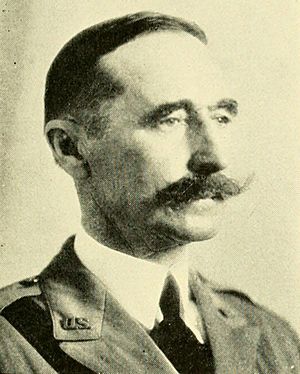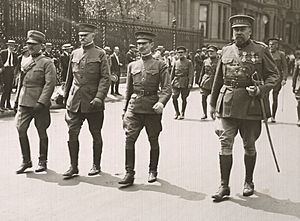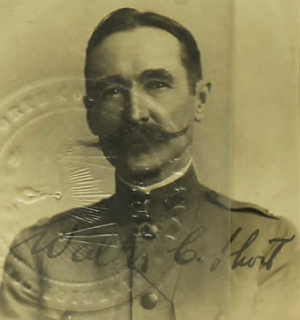Walter Cowen Short facts for kids
Quick facts for kids
Walter Cowen Short
|
|
|---|---|

From 1920's History of the Ohio State University
|
|
| Born | April 2, 1870 Columbus, Ohio |
| Died | March 5, 1952 (aged 81) San Diego, California |
| Buried |
Fort Rosecrans National Cemetery
|
| Allegiance | United States |
| Service/ |
United States Army |
| Years of service | 1891-1934 |
| Rank | Brigadier General |
| Service number | 0-399 |
| Unit | U.S. Cavalry Branch |
| Commands held | Troop L, 6th Cavalry Regiment Troop A, 6th Cavalry Regiment Bayamo, Cuba Fort Yosemite, California 337th Infantry Regiment 312th Cavalry Regiment 315th Cavalry Regiment 71st Artillery Regiment 72nd Artillery Regiment 32nd Infantry Brigade, 16th Division 16th Cavalry Regiment 7th Cavalry Regiment 2nd Cavalry Brigade Fort Bliss, Texas 1st Cavalry Division |
| Battles/wars | Garza Revolution Spanish–American War United States Military Government in Cuba Philippine–American War Pancho Villa Expedition World War I |
| Awards | Silver Star Purple Heart |
| Spouse(s) | Hortense DuBois Wilson (m. 1901–1934, his death) |
| Children | 1 |
| Relations | Sidney Howe Short (brother)
John Thomas Short(brother)
|
Walter C. Short (born April 2, 1870 – died March 5, 1952) was a brave and important officer in the United States Army. He fought in several big conflicts, including the Spanish–American War, the Pancho Villa Expedition, and World War I. He rose through the ranks to become a brigadier general. General Short was especially known for training many army units during World War I and for leading the 1st Cavalry Division between the two World Wars.
Contents
Early Life and Education
Walter Cowen Short was born in Columbus, Ohio on April 2, 1870. He grew up and went to school in Columbus. He studied at Marietta College from 1887 to 1888. Later, he attended the preparatory department at Ohio State University from 1888 to 1889. Short also went to Michigan Military Academy from 1889 to 1890. After graduating, he stayed at the academy as a teacher, instructing in grammar and arithmetic.
Joining the Army
While at Marietta College, Short joined the Ohio National Guard. He quickly became a captain and served for two years. In 1889, he was made a colonel on the staff of Governor Joseph B. Foraker. One of his jobs was to help arrange for Ohio National Guard troops to be part of Benjamin Harrison's inauguration as president.
In 1891, U.S. Army officers were impressed by Short's leadership at the Michigan Military Academy. When a spot opened up for a lieutenant in the 6th Cavalry Regiment, they recommended him. Even though 1,800 people had applied, Short was chosen. He passed a tough exam and became a second lieutenant in the Cavalry on October 7, 1891.
Short's first assignment was with the 3rd Cavalry at Fort Sam Houston, Texas. Soon after he arrived, the Garza Revolution began. Short was sent to Fort Ringgold with two cavalry troops. He quickly took command and led his troops in stopping attacks along the Texas-Mexico border. His units captured several prisoners during this time.
After Texas, Short joined the 6th Cavalry in Nebraska. He commanded Troop L, which was made up of American Indian scouts. He also served with the 6th Cavalry in Chicago during the 1894 Pullman Strike.
Heroism in the Spanish–American War
When the Spanish–American War started in 1898, Short was given command of the 6th Cavalry's Troop A. He was offered a higher temporary rank, but he chose to stay with his regiment and fight on the front lines in Cuba.
In Cuba, Short was promoted to temporary captain. The 6th Cavalry led the charge at the Battle of San Juan Hill on July 1, 1898. Most soldiers had to leave their horses behind because of the difficult land. Short rode his horse to better lead his troops, but his horse was shot. He kept leading on foot and was one of the first soldiers to reach the top of the hill.
During the battle, Short was shot three times. One bullet went through his side, another wounded his arm, and a third hit his wrist. Even with these serious injuries, he kept fighting until the Spanish army's defenses were broken. His friends, including John J. Pershing, carried him off the battlefield, thinking he might not survive. A famous photo in The Illustrated London News showed Short being carried, making him well-known.
Short was taken to a military hospital in Key West, Florida. After only ten days, he felt well enough to sneak out and rejoin the 6th Cavalry in Cuba. He received a special promotion to major for his bravery and stayed in Cuba until the war ended.
After the Wars
After the Spanish-American War, Short served with the 10th Cavalry in Kansas and Texas. He then returned to Cuba to help with the United States Military Government in Cuba. Short became the unofficial governor of Bayamo and nearby towns. Under his leadership, soldiers drove out gangs of robbers, improved sanitation, opened new schools, and built telegraph lines and better roads.
After Cuba, Short served in the Philippines during the Philippine–American War. In 1901, he was promoted to captain in the 13th Cavalry.
In 1902, the Army opened the Cavalry School at Fort Riley. Short was chosen as its first main instructor. He taught there until 1907, when he went to study at the Cavalry School in Saumur, France. After learning about French teaching methods, Short returned to Fort Riley as the assistant leader of the Cavalry School until 1911.
Short was assigned to the 1st Cavalry Regiment in 1911. He also commanded Fort Yosemite and the troops who looked after Yosemite National Park. In 1915, he was promoted to major and served on the Texas-Mexico Border during the Pancho Villa Expedition.
World War I Contributions
In May 1917, soon after the American entry into World War I, Short was promoted to lieutenant colonel. In August 1917, he became a temporary colonel and was put in charge of organizing and training the 337th Infantry Regiment. He also organized and trained the 312th and 315th Cavalry Regiments.
When the Army decided that Cavalry units were not needed on the front lines in France, Short was responsible for changing these regiments into Field Artillery units. They then went to France as the 71st and 72nd Artillery Regiments.
In October 1918, Short was promoted to temporary brigadier general. He commanded the 32nd Brigade of the 16th Division. However, the war ended on November 11, 1918, before his division went to France. Short returned to his permanent rank of lieutenant colonel in 1919.
Later Career and Retirement
After World War I, Short went to Belgium as the manager for the U.S. equestrian (horse riding) team at the 1920 Summer Olympics. He then attended the United States Army Command and General Staff College. After graduating, he was promoted to colonel and commanded the 16th Cavalry. In 1921, he took command of the 7th Cavalry.
In October 1927, Short was promoted to brigadier general. He served at various army schools, including the Advanced Air Corps School and the Cavalry School. In 1928, he took command of the 2nd Cavalry Brigade at Fort Bliss, Texas. He also managed the U.S. equestrian team at the 1928 Summer Olympics in Amsterdam.
General Short commanded the 1st Cavalry Division from 1930 to 1932, and again in 1934. He also commanded Fort Bliss in 1933. Short retired from the Army in April 1934.
Death and Family
After retiring, Walter C. Short lived in San Diego, California. He passed away at the Naval Medical Center San Diego on March 5, 1952. Short was buried at Fort Rosecrans National Cemetery in San Diego.
In 1901, Short married Hortense DuBois Wilson in Omaha, Nebraska. They had one daughter, Hortense Wilson, who later married Major General Verne D. Mudge.
Awards and Recognition
General Short received the Silver Star Citation for his service in the Spanish–American War. This award was later upgraded to the Silver Star when that medal was created in 1918. He also received the Purple Heart for the wounds he got during the Battle of San Juan Hill.




